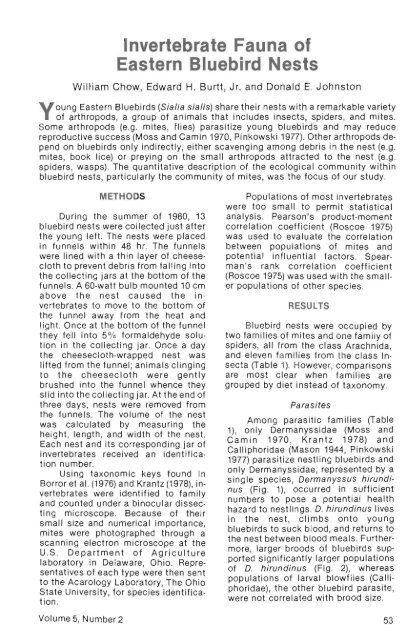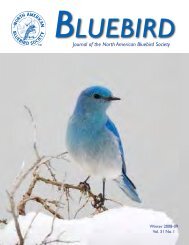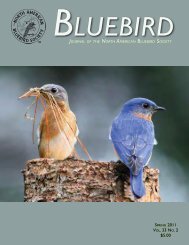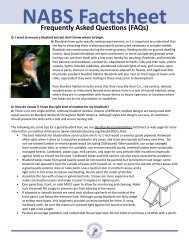Vol. 5, No. 2; Spring 1983 - North American Bluebird Society
Vol. 5, No. 2; Spring 1983 - North American Bluebird Society
Vol. 5, No. 2; Spring 1983 - North American Bluebird Society
You also want an ePaper? Increase the reach of your titles
YUMPU automatically turns print PDFs into web optimized ePapers that Google loves.
Invertebrate Fauna of<br />
Eastern <strong>Bluebird</strong> Nests<br />
William Chow, Edward H . Burtt, Jr. and Donald E. Johnston<br />
Young Eastern <strong>Bluebird</strong>s (Sia/ia sia/is) share their nests with a remarkable variety<br />
of arthropods, a group of animals that in cludes insects, spiders, and mites.<br />
Some arthropod s (e.g. mites, flies) parasitize young bluebirds and may reduce<br />
reproductive su ccess (Mo ss and Carnin 1970, Pin kowski 1977). Other arthropods depend<br />
on bluebirds onl y indirectly, either sc avenging among debris in the nest (e.g.<br />
mites, bo ok lic e) or preying on the small arthropods attracted to the nest (e.g.<br />
spiders, wasps). The quantitative description of the ecological community within<br />
bluebird nests, particularly the co mmunity of mites, was the fo cus of our study.<br />
METHODS<br />
Duri ng th e su mmer of 1980, 13<br />
bluebird nests were collected just after<br />
the young left. The nests were placed<br />
in funnels within 48 hr. The funnels<br />
were lined with a thin layer of ch eesec<br />
loth to prevent debris from falling into<br />
the collect in g jars at the bottom of the<br />
funnels. A 60-watt bulb mounted 10 cm<br />
above the nest caused the in <br />
vertebrates to mo ve to th e bottom of<br />
th e funnel away from the heat and<br />
li ght. Once at the bottom of th e funnel<br />
they fell into 5 % formaldehyde solution<br />
in the collecting jar. Once a day<br />
the cheesec loth-wrapped nest was<br />
lifted from the funnel; animals clinging<br />
to the c hee sec lot h were gently<br />
brushed into the funnel whence they<br />
slid into th e col lecting jar. At the end of<br />
three days, nests were removed from<br />
the funnels. The volume of the nest<br />
was calculated by measuring the<br />
height, length , and width of th e nest .<br />
Each nest and it s c or res pond ing jar of<br />
invertebrates received an identification<br />
number.<br />
Using ta xonomic keys found in<br />
Borror et al. (1976) and Krantz (1978), invert<br />
ebrates were identified to family<br />
and c ounted under a binocular dissecting<br />
microscope. Because of their<br />
small size and numerical import ance,<br />
mites were photographed through a<br />
scanning electron microscope at the<br />
U.S. Department of Agriculture<br />
laboratory in Delaware, Ohi o. Represent<br />
at ives of each type were then sent<br />
to the Acarology Laboratory, ThE) Ohio<br />
State Uni versity, for spe cies identification.<br />
<strong>Vol</strong>ume 5, Number 2<br />
Populations of mo st invertebrates<br />
were too small to permit statistical<br />
ana lysis. Pears on 's product-moment<br />
c arrelation coeffici ent (Rosc oe 1975)<br />
was used to evaluate the correlation<br />
between populations of mites and<br />
potential influential fa ctors. Spearman's<br />
rank c orrelation c oeffic ient<br />
(Roscoe 1975) was used with the s maller<br />
populations of other species .<br />
RESULTS<br />
<strong>Bluebird</strong> nests were occupied by<br />
two families of mites and one family of<br />
spiders, all from the class Arach nida,<br />
and eleven fami lies fr om t he class lnsecta<br />
(Table 1). However, comparisons<br />
are most c lear wh en families are<br />
grouped by diet instead of ta xonomy.<br />
Para sites<br />
Among parasitic families (Table<br />
1), only Dermanyssidae (Mo ss and<br />
Camin 1970, Krantz 1978) and<br />
Calliphoridae (Maso n 1944, Pinkow ski<br />
1977) parasitize nestling bluebirds and<br />
onl y Dermanyssidae, represented by a<br />
s ing le s pec ies, Dermanyssus birundinus<br />
(Fig. 1), occurred in sufficient<br />
numbers to pose a potential health<br />
hazard to nestlings. D. hirundinus lives<br />
in the nest, climbs onto young<br />
bluebirds to suck blood, and returns to<br />
the nest between blood meals. Furthermore,<br />
larger bro ods of bluebirds supported<br />
s ignific ant ly larg er populations<br />
of D. hirundinus (Fig. 2), whereas<br />
populations of lar val blowflies (Call i<br />
phoridae), the ot her bluebird parasite,<br />
were not correlated with brood siz e.<br />
53





